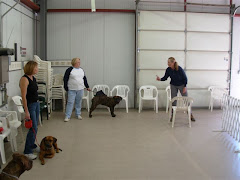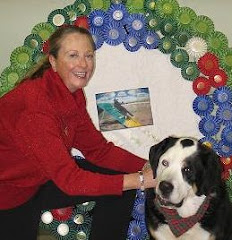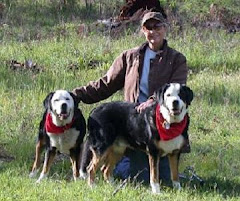
 Jan,
Jan, I just adopted a young Bouvier who was raised in a kennel with inadequate socialization with people. She's timid, acts very detached from us, and urinates submissively when I go toward her to bring her in the house after a play session. She never runs from me, but she will pee. How can I help her overcome this submissive behavior and help her bond with me?
--Sandi
Sandi,
A drag leash is a fast, easy, efficient way to help the dog bond with you and make things happen "your way" without getting overbearing or without feeding into her insecurities. The leash can be an inexpensive nylon puppy lead or even a piece of yellow poly rope as I have pictured here. Put a lightweight snap on it...or simply tie a hunk onto your dog's collar. Make it about four feet long.
Leave the leash on your dog whenever you can watch her, indoors and out, whether she "needs" a leash on her or not. Let her get comfortable with it hanging around her legs and under her feet. Let her learn to play, nap, and eat while wearing it.
This leash is your "handle" to your dog. It's the control mechanism. It's a way to make things happen without invading your dog's space (which is what makes her pee, because it's intimidating to her). After she's lived with you a while and knows you have this magical power to get her to do things without hurting her, she'll start to accept you, she'll become more trusting, and she'll actually start looking to you for comfort and security instead of withdrawing into herself.
Let's say she just went outside to pee, and now it's time for her to come in. She's wearing the drag leash and she just sits there when you call her to the door. Go quietly to her, keeping your body language "soft." Avoid direct eye contact with her. Without touching her, simply pick up the end of the drag leash and bring her into the house. As you walk with her, look straight ahead and not at her. Use a word of encouragement if you want, but don't beg or bargain with her. Just get her in the house. If you have to "haul" her in, gently but forcefully do so, and don't make a big deal of it. Once you're both inside, offer another simple word of praise and then go about your business.
When you travel from room to room throughout your home, pick up her drag leash, give her a word of encouragement, and GO with her in tow. Take her into the bathroom with you. Take her everywhere, leash in hand. As before, don't bother with commands. Just do it. Soon you won't have to hold the leash; she'll get up and go with you because you've become her comfort zone and security blanket. That's good. Leave the leash on her anyway, until you think she just doesn't need it anymore.
Use the leash for remedial training any time throughout her life. Like a crate, she should never perceive it as "punishment," but rather a routine part of her life. It will become a "thinking cap" for her. You'll see her slow down and think things through more clearly when she's wearing her magic leash.
Don't put a fancy or expensive leash on her because she'll probably chew it up and/or get it very dirty. The drag leash should be washable and replaceable. That's why I like the lightweight nylon leashes or the poly rope leashes. When she chews it up (which she probably will for a while), just tie on a new hunk, or put a knot in the middle.
When service dogs are first paired with their new disabled owners, they spend three solid weeks "tied" to each other. The owners must do EVERYTHING with the dog attached to them. The same principle works for our companion dogs, especially for those who need extra encouragement to bond with us.
Of all the tools you can use to integrate a new dog (of any age) into your life, there is absolutely nothing that has more power than a simple drag leash.
--Jan


















1 comment:
A walker or walking frame is a tool for disabled or elderly people who need additional support to maintain balance or stability while walking. In the well known country a common equivalent term for a walker is walking frame. Walking frames is good mobility devices for any age people.
Post a Comment